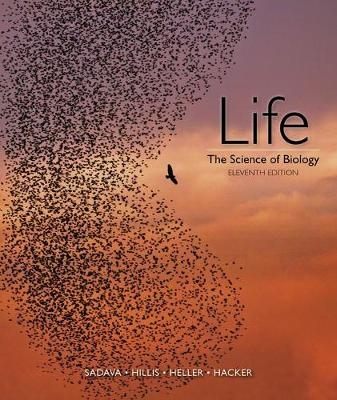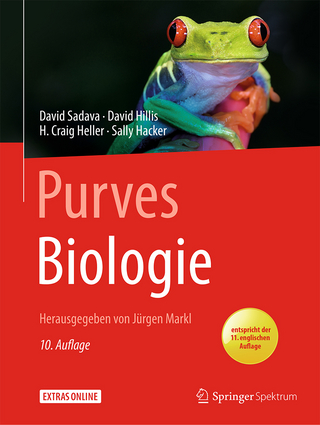
Life: The Science of Biology
W.H.Freeman & Co Ltd (Verlag)
978-1-319-01016-4 (ISBN)
- Titel erscheint in neuer Auflage
- Artikel merken
David E. Sadava is the Pritzker Family Foundation Professor of Biology, Emeritus, at the Keck Science Center of Claremont McKenna, Pitzer, and Scripps, three of The Claremont Colleges. In addition, he is Adjunct Professor of Cancer Cell Biology at the City of Hope Medical Center. Twice winner of the Huntoon Award for superior teaching, Dr. Sadava has taught courses on introductory biology, biotechnology, biochemistry, cell biology, molecular biology, plant biology, and cancer biology. In addition to Life: The Science of Biology, he is the author or coauthor of books on cell biology and on plants, genes, and crop biotechnology. His research has resulted in many papers coauthored with his students, on topics ranging from plant biochemistry to pharmacology of narcotic analgesics to human genetic diseases. For the past 15 years, he has investigated multi-drug resistance in human small-cell lung carcinoma cells with a view to understanding and overcoming this clinical challenge. At the City of Hope, his current work focuses on new anti-cancer agents from plants. David M. Hillis is the Alfred W. Roark Centennial Professor in Integrative Biology at the University of Texas at Austin, where he also has directed the Center for Computational Biology and Bioinformatics and the School of Biological Sciences. Dr. Hillis has taught courses in introductory biology, genetics, evolution, systematics, and biodiversity. He has been elected to the National Academy of Sciences and the American Academy of Arts and Sciences, awarded a John D. and Catherine T. MacArthur Fellowship, and has served as President of the Society for the Study of Evolution and of the Society of Systematic Biologists. He served on the National Research Council committee that wrote the report BIO 2010: Transforming Undergraduate Biology Education for Research Biologists, and currently serves on the Executive Committee of the National Academies Scientific Teaching Alliance. His research interests span much of evolutionary biology, including experimental studies of evolving viruses, empirical studies of natural molecular evolution, applications of phylogenetics, analyses of biodiversity, and evolutionary modeling. He is particularly interested in teaching and research about the practical applications of evolutionary biology. H. Craig Heller is the Lorry I. Lokey/Business Wire Professor in Biological Sciences and Human Biology at Stanford University. He has taught in the core biology courses at Stanford since 1972 and served as Director of the Program in Human Biology, Chairman of the Biolo-gical Sciences Department, and Associate Dean of Research. Dr. Heller is a fellow of the American Association for the Advancement of Science and a recipient of the Walter J. Gores Award for excellence in teaching and the Kenneth Cuthberson Award for Exceptional Service to Stanford University. His research is on the neurobiology of sleep and circadian rhythms, mammalian hibernation, the regulation of body temperature, the physiology of human performance, and the neurobiology of learning. He has done research on a huge variety of animals and physiolo-gical problems, including from sleeping kangaroo rats, diving seals, hibernating bears, photo-periodic hamsters, and exercising athletes. Dr. Heller has extended his enthusiasm for promoting active learning via the development of a two-year curriculum in human biology for the middle grades, through the production of Virtual Labs--interactive computer-based modules to teach physiology. Sally D. Hacker is Professor at Oregon State University where she has been a faculty member since 2004. She has taught courses in introductory ecology, community ecology, invasion biology, field ecology, and marine biology. She was awarded the Murray F. Buell Award by the Ecological Society of America and the Young Investigator Prize by the American Society of Naturalists. Dr. Hacker's research explores the structure, function, and services of natural and managed ecosystems under varying contexts of species interactions and global change. She has conducted research with plants and animals in rocky intertidal, salt marsh, seagrass, and coastal dune ecosystems. Her work has most recently focused on the protective role of dune ecosystems in mitigating coastal vulnerability due to climate change. In addition to the textbooks Life: The Science of Biology and Ecology, she is author or coauthor on numerous articles and book chapters exploring community ecology, species interactions, marine invasions, and ecosystem services important to coastal management. She is particularly interested in promoting active and experiential learning for students interested in ecology and field-emersion experiences.
Part ONE The Science of Life and Its Chemical Basis 1 Studying Life.- 2 Small Molecules and the Chemistry of Life.- 3 Proteins, Carbohydrates, and Lipids.- 4 Nucleic Acids and the Origin of Life.- Part TWO Cells 5 Cells: The Working Units of Life.- 6 Cell Membranes.- 7 Cell Communication and Multicellularity.- Part THREE Cells and Energy 8 Energy, Enzymes, and Metabolism.- 9 Pathways that Harvest Chemical Energy.- 10 Photosynthesis: Energy from Sunlight.- Part FOUR Genes and Heredity 11 The Cell Cycle and Cell Division.- 12 Inheritance, Genes, and Chromosomes.- 13 DNA and Its Role in Heredity.- 14 From DNA to Protein: Gene Expression.- 15 Gene Mutation and Molecular Medicine.- 16 Regulation of Gene Expression.- Part FIVE Genomes 17 Genomes.- 18 Recombinant DNA and Biotechnology.- 19 Genes, Development, and Evolution.- Part Six The Patterns and Processes of Evolution 20 Processes of Evolution.- 21 Reconstructing and Using Phylogenies.- 22 Speciation.- 23 Evolution of Genes and Genomes.- 24 The History of Life on Earth.- Part SEVEN The Evolution of Diversity.- 25 Bacteria, Archaea, and Viruses.- 26 The Origin and Diversification of Eukaryotes.- 27 Plants without Seeds: From Water to Land.- 28 The Evolution of Seed Plants.- 29 The Evolution and Diversity of Fungi.- 30 Animal Origins and the Evolution of Body Plans.- 31 Protostome Animals.- 32 Deuterostome Animals.- Part Eight Flowering Plants: Form and Function.- 33 The Plant Body.- 34 Transport in Plants.- 35 Plant Nutrition.- 36 Regulation of Plant Growth.- 37 Reproduction in Flowering Plants.- 38 Plant Responses to Environmental Challenges.- Part NINE Animals: Form and Function.- 39 Physiology, Homeostasis, and Temperature Regulation.- 40 Animal Hormones.- 41 Immunology: Animal Defense Systems.- 42 Animal Reproduction.- 43 Animal Development.- 44 Neurons, Glia, and Nervous Systems.- 45 Sensory Systems.- 46 The Mammalian Nervous System.- 47 Musculoskeletal Systems.- 48 Gas Exchange.- 49 Circulatory Systems.- 50 Nutrition, Digestion, and Absorption.- 51 Salt and Water Balance and Nitrogen Excretion.- 52 Animal Behavior.- Part Ten Ecology 53 The Physical Environment and Biogeography of Life.- 54 Populations.- 55 Species Interactions.- 56 Communities.- 57 Ecosystems.- 58 A Changing Biosphere.
| Erscheinungsdatum | 04.01.2017 |
|---|---|
| Sprache | englisch |
| Maße | 155 x 235 mm |
| Themenwelt | Naturwissenschaften ► Biologie |
| ISBN-10 | 1-319-01016-4 / 1319010164 |
| ISBN-13 | 978-1-319-01016-4 / 9781319010164 |
| Zustand | Neuware |
| Haben Sie eine Frage zum Produkt? |
aus dem Bereich



